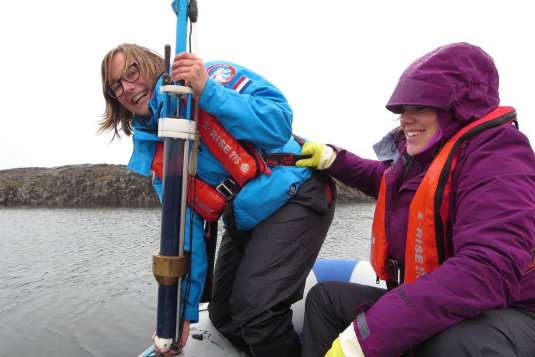Rapid changes in the high Arctic

A new study led by an INSTAAR postdoctoral researcher has found dramatic shifts in the ecosystem of a remote archipelago in the Arctic Ocean in response to recent climate change.
Published today in the open-access journal Scientific Reports, the study finds explicit links between changes in biological systems and climate change in the Arctic. In line with other studies, it shows that the high Arctic, which is warming faster than any other region on Earth, is already undergoing rapid ecosystem change and will continue to transform in the future.
Lineke Woelders, currently at INSTAAR and previously a Ph.D. student at KU Leuven, Belgium, took advantage of being at a very remote lake on an island of East Svalbard to take a core sample of the lake sediments.
East Svalbard is an uninhabited part of the Svalbard archipelago in the Arctic Ocean, and is so inaccessible that researchers have only rarely been able to travel there to retrieve records and direct observations. Woelders, together with co-authors Keechy Akkerman and Wim Hoek (Utrecht University) and Thomas van Hoof (TNO Applied Geosciences), was part of a research and outreach cruise, Netherlands Scientific Expedition Edgeøya Spitsbergen (SEES.NL), that took researchers to islands in East Svalbard in August 2015.
The benefit of having a lake sediment core from a place so far from population centers is that it can show ecology shifting in response to climate change without being masked by signals from nearby human activity. "The core let us see recent climate change and what it did to ecology there, far from people," says Woelders.
Each year, sediments settle on the bottom of lakes, bearing pollen grains, algae, and the remains of tiny creatures that live in the water. By studying the layers left behind in succeeding years, researchers can see many lines of evidence that help them reconstruct the ecology in and around the lake.
Sedimentation in Arctic lakes can be slow, sometimes accreting only a couple of inches in 200 years. Woelders got lucky: they wound up with a sample 18 inches (45 centimeters) long recording 125 years, from 1890 to 2015. The length of the sample let Woelders and her colleagues date the core accurately and see recent changes in detail. "It's a way of going back in time without being there—that's why I love paleo," says Woelders.
Once back in the lab, Woelders and co-authors Akkerman and Kimberley Hagemans (Utrecht University) looked at layers of the core to find out about the ecology of the lake through time. Pollen grains showed what plants grew there. Green algae indicated productivity, or the rate of new biomass produced in a system. And the shells of diatoms, single-celled algae that are the most common form of phytoplankton, recorded information about water quality.
While Woelders reconstructed traces of the ecology recorded in the lake sediment core, fellow scientist Jan Lenaerts brought together climate and sea ice data sources from the surrounding area. Lenaerts, at the time a post-doctoral researcher at Utrecht University and now an assistant professor in the Atmospheric and Oceanic Sciences department at CU Boulder, is also Woelders' husband. This study was the first time they had been able to work together on an investigation. "This was a long-time wish of ours," says Woelders.
Lenaerts reconstructed temperature from surrounding meterological stations in the archipelago with data back to 1960. He also dug out satellite images, available back to the 1980s, that show the extent of nearby sea ice cover, which drives local climate at the lake's location near the ocean.
The core shows a sudden, dramatic shift in the ecosystem of the lake.
"From 1890 until 1980," says Woelders, "you saw only a small increase in the number of algae per gram." The amount of algae in a core is evidence for the rate of new biomass produced in an environment. "From the early 1990s onward, they just exploded. All of a sudden, we saw a hundred times more algae than a century before."
The new algae weren't there because of more nutrients in the system, either. Between 1950 and 2000 the groups of diatoms most prevalent in the lake changed substantially, but those changes did not indicate a shift in the amount of nitrogen or other nutrients in the water.
Days above freezing, however, increased dramatically after 1960. Each decade there were 11 more days above freezing per year than the decade before. In addition, the sea-ice free period near the lake increased from about three months per year in the late 1980s to six months per year in 2010-2014. Temperature shifts are the most likely cause of the ecosystem changes seen in the core. "The results align with other studies of the Arctic," says Woelders.
"I had never seen anything like this before, and I'd never seen a signal so clear. At first we thought we'd done something wrong with the samples," reflects Woelders. "When you start realizing what you're seeing and how fast things are changing, you get humbled. Okay, so this is what climate change is doing in the Arctic."
More information: Lineke Woelders et al. Recent climate warming drives ecological change in a remote high-Arctic lake, Scientific Reports (2018). DOI: 10.1038/s41598-018-25148-7
Journal information: Scientific Reports
Provided by University of Colorado at Boulder





















